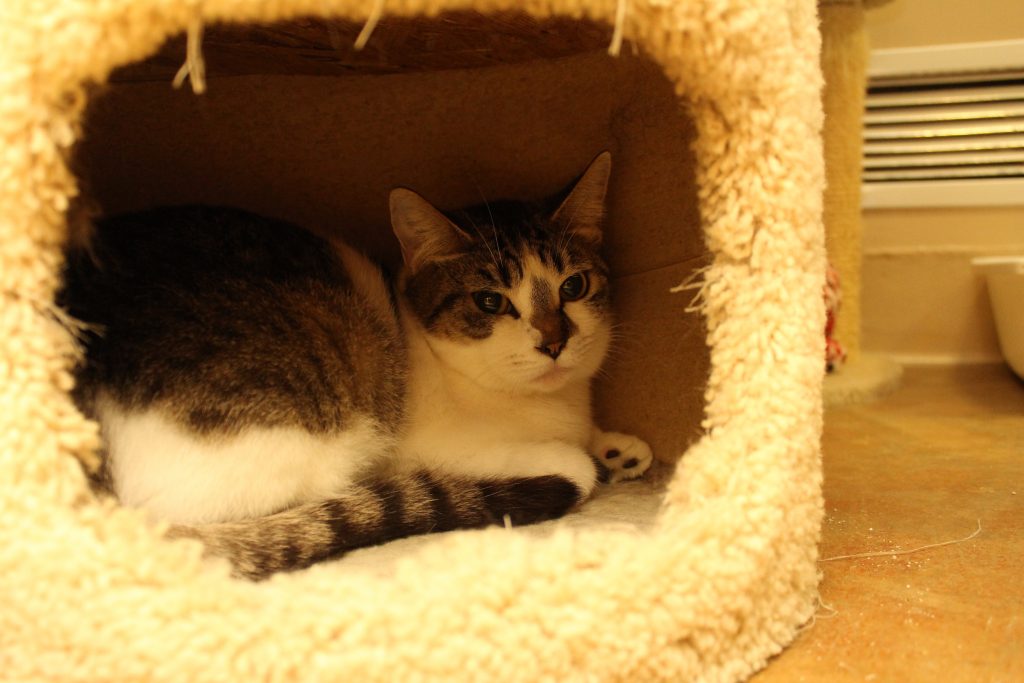I am a big fan of new behavioral studies that can help cats, and I’m also a big fan of using clicker training with cats. So when I saw a new study, “Clicker training increases exploratory behavior and time spent at the front of the enclosure in shelter cats,” had been published, I was very excited to check it out.
Unfortunately, the paper is a good example of why we have to be careful about drawing conclusions from research and for those of us who do research, why we have to be careful about how we design studies.

There’s no doubt that shelters are a stressful environment for most cats. Being in a shelter usually means that cats have been removed from their familiar territory and all that is contains (smells, sounds, familiar humans and other animals). There are other animals present in distress, and cats may have to be handled for medical treatment, and may not have the ability to escape fear-provoking stimuli. Previous studies have shown that a hiding space, enrichment, and some types of handling can provide benefits for shelter cats.
The current study intended to determine if clicker training for shelter cats could improve their outcomes by increasing activity and exploratory behaviors, things that might help shelter cats get adopted more quickly. The study included twelve singly-housed cats in an animal shelter, who received 10 minutes of clicker training, 3 times a week for two weeks.
Cats were first trained to make a connection between the clicker sound and a food reinforcement (we call this “charging the clicker”). Next, the trainer made the clicker sound and offered food any time the cat made a movement toward them, essentially shaping the cat to approach the front of their enclosure in exchange for a treat.

The results appear impressive – by the end of two weeks, cats spent more time at the front of the cage, and more time exploring. The training had no effect on whether cats showed more “friendly” behaviors (as rated by the “Human Approach Test,” or HAT, which assesses how cats respond to strange humans – do they approach or sniff an offered hand, or withdraw or show signs of aggression?). This all sounds great!! So where did things go wrong?
The fatal flaw in this study is that there is no control group – meaning a group of cats who did not receive the clicker training but were also tested for improvements in activity, exploration, and friendly behaviors. As someone who spent many years working in an animal shelter, I can attest to the fact that most cats will improve with time in a shelter environment just because they adjust to their new environment. In fact, previous research has shown that cats’ stress levels in novel environments improves significantly in 14 days…the same time frame as that in the clicker training study.
You need control
Without a control group, it is NOT POSSIBLE to say that the clicker training contributed anything to the improvements in behavior observed in these cats. It’s a behavioral equivalent of a placebo effect – these cats may have improved significantly with or without clicker training.
Another concern with this study is that the researchers did not control for how long the cats had been in the shelter when the clicker training was started. The range of time the cats had been in the study at the start of clicker training ranged from 2 to 21 days. If you looked at the four cats who improved on HAT scores, they had an average length of stay of 14.5 days when training began, compared to the other eight cats who had been in the shelter an average of 6.25 days when training started, again supporting a strong effect for time in the shelter on the cats’ behavior.
I don’t really like blogging to tear apart a study – doing research is difficult, and when doing research there are often minor flaws or things that if we could go back in time, we would do differently, no doubt. But the flaw in this study as presented is so fatal, that I’m surprised it was published as is (even the title suggests experimental support for the hypothesis that clicker training effects shelter cat behavior).
The sad thing is that this flaw could have easily been fixed just by having a control group of cats who did not receive clicker training, and seeing whether and how much their behavior changed during the same two week period (ideally, matching those cats to the clicker trained cats on how long they had already been in the shelter). If the researchers had done this, we might be playing a whole different ballgame folks.
Because when you do science, you can’t just think about what might prove your idea or hypothesis (“clicker training will increase activity in two weeks”) – you have to think about what would DISPROVE your idea or hypothesis – what are the OTHER possible explanations (“cats will become more active in the shelter in two weeks without clicker training,” “cats will become more active in a shelter in two weeks if they are offered toys to play with” etc.). Especially when it has already been demonstrated that cats improve in a new environment in about two weeks ANYWAY, to not control for this factor is doing the field of cat behavior research a disservice.
There are some classic writings on how to think about these issues when doing science, first of all, John Platt’s “Strong Inference” and Richard Chamberlain’s 1965 paper “The Method of Multiple Working Hypotheses” are every bit as relevant today as they were when published over 50 years ago (and should be required reading for anyone who is “science-ing”). The overarching messages: design your studies to get clean results, consider alternative possible explanations, and try to control for them. This is why including placebos and blinding folks is the gold standard for testing new medical treatments.
Hopefully someone will take the initiative to test the effects of clicker training on cats with these messages in mind in the future, so we can know for sure whether clicker training offers additional benefits for shelter cats above and beyond the effects of just getting comfortable with more time in the shelter.

References
Chamberlin, T. C. (1965). The method of multiple working hypotheses. Science, 754-759.
Gourkow, N., & Phillips, C. J. (2015). Effect of interactions with humans on behaviour, mucosal immunity and upper respiratory disease of shelter cats rated as contented on arrival. Preventive Veterinary Medicine, 121(3-4), 288-296.
Grant, R. A., & Warrior, J. R. (2019). Clicker training increases exploratory behaviour and time spent at the front of the enclosure in shelter cats; Implications for welfare and adoption rates. Applied Animal Behaviour Science, 211, 77-83.
Kessler, M. R., & Turner, D. C. (1997). Stress and adaptation of cats (Felis silvestris catus) housed singly, in pairs and in groups in boarding catteries. Animal Welfare, 6(3), 243-254.
Platt, J. R. (1964). Strong inference. Science, 146(3642), 347-353.
Stella, J. L., Croney, C. C., & Buffington, C. T. (2017). Behavior and welfare of domestic cats housed in cages larger than US norm. Journal of Applied Animal Welfare Science, 20(3), 296-312.



